Intel’s Sandy Bridge i7-2820QM: Upheaval in the Mobile Landscape
by Jarred Walton on January 3, 2011 12:00 AM EST- Posted in
- Laptops
- Intel
- Sandy Bridge
- Compal
Mobile Sandy Bridge Medium Gaming Performance
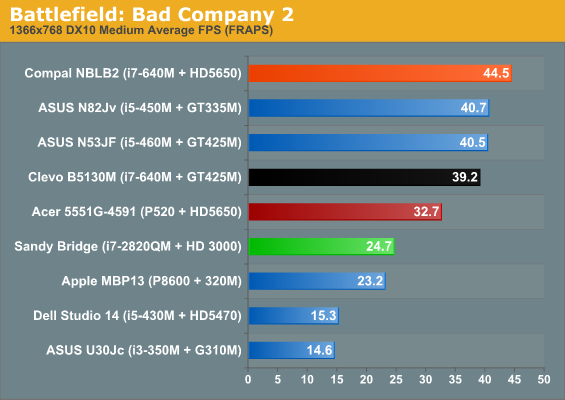
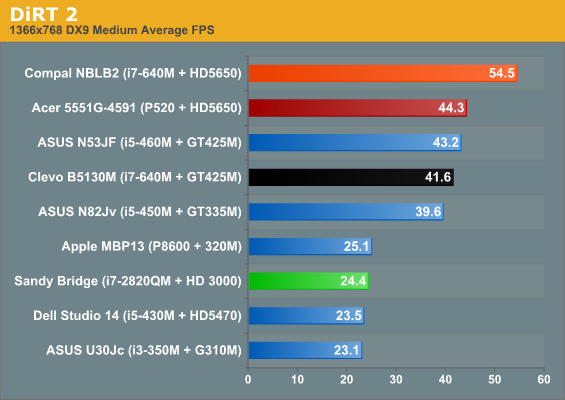
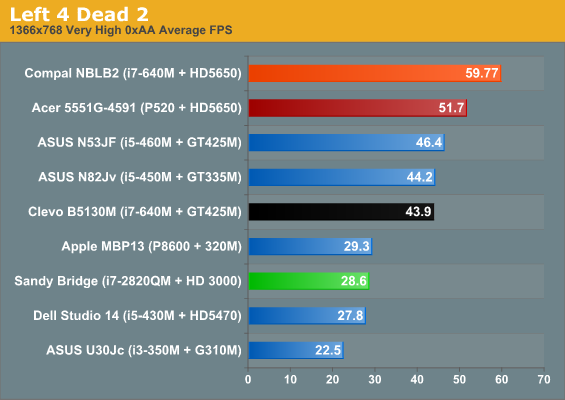

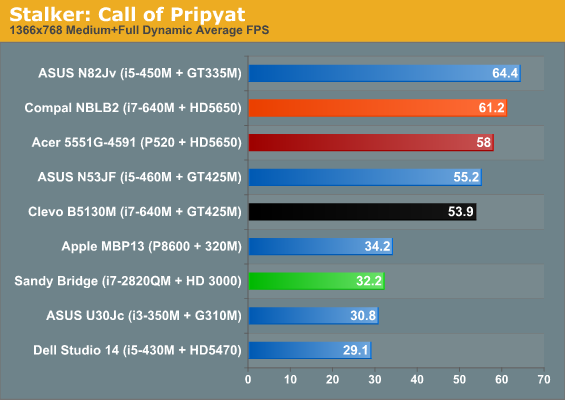
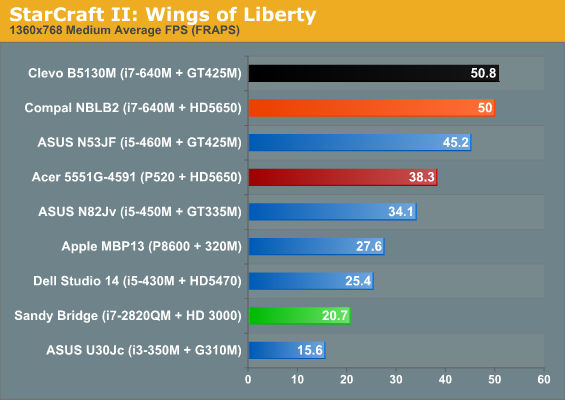
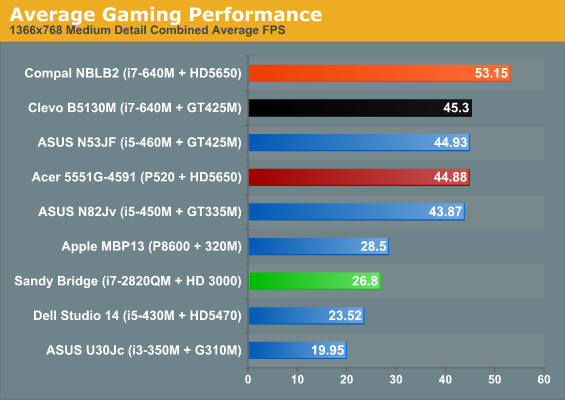
Moving up to medium detail, the picture becomes a lot less rosy. We’ll just forget about the Arrandale IGP and HD 4250 now, as they were generally slow to unplayable at Low settings and become untenable at Medium. Overall, HD 3000 still leads the HD 5470, but the GeForce 320M actually turns in better results at Medium detail and ends up 6% faster. The P520 + HD 5650 lead is now 67%, since more of the bottleneck is shifted to the GPU, or 98% when coupled to Arrandale. NVIDIA’s GT 425M also leads by 68%. If we’re looking for reasonably smooth gaming performance, only Mass Effect 2 and STALKER manage to squeak past the 30FPS mark.
At the Medium settings, we also encountered a few minor glitches with rendering games. For the above six titles, Left 4 Dead 2 is the only problem, with darker graphics than on other GPUs and a much more pronounced film grain effect. You can turn down the latter setting to compensate, but even at maximum brightness the game is still darker than on AMD and NVIDIA graphics. A driver update should be able to address this, but it does serve to illustrate the fact that not all titles will run 100% properly on the current Intel drivers.
That last point raises an interesting question: just how many games will have minor glitches or other issues with the Sandy Bridge IGP? Without testing each game for compatibility, we can’t provide an answer, but we did pull out a large selection of older and newer titles for additional testing. If you have any further requests, feel free to ask and we can try to see if the game(s) in question will run on Sandy Bridge or not—bearing in mind that we don’t have access to all current titles. So let’s see how SNB graphics fare on 14 additional games.










66 Comments
View All Comments
seamusmc - Friday, January 7, 2011 - link
I'm a notebook noob, up till now I've avoided them as much as I could. I have evaluated them over the years and have a pretty good dell precision 4500 at work, however, I had to build a desktop because the laptop, as provided, just doesn't cut it. With a SSD and 8 GB of ram it would probably suffice but I run a lot of Virtual Machines for testing.Anyhoo, enough of my background: I am very interested in the Sandy Bridge line specifically the retail chips, 2720 and 2820.
However all I'm seeing announced from the OEM's are 2630 based solutions. Are the OEM's going to have an option to upgrade to the retail chips? Are the 2720 and 2820 going to be available any time soon or is it just the 2630 that will have broad availability?
Who will have the retail chips available?
GullLars - Saturday, January 8, 2011 - link
This review unit came with an Intel SSD, which probably made a huge impact on general usage, but can we expect SSD boot drives for most Sandy Bridge laptops?If i were Intel, i'd make a branding program where Sandy + Intel SSD (310, G2, or newer) gave a fancy sticker for marketers to drool over, guaranteeing smooth and snappy operation without hiccups from spinning platter IOs.
IntoGraphics - Monday, January 17, 2011 - link
"We might get some of the above in OEM systems sent for review, and if so it will be interesting to see how much of an impact the trimmed clock speeds have on overall performance."Looking forward for this to happen. Very important to know for me. Because I will be using Adobe Illustrator CS4, Cinema 4D R12 Prime, and Unity 3D.
I hope that the performance impact between an i7-2720QM and a i7-2820QM, is as minimal as it was between the i7-740QM and i7-840QM.
It's going to be a toss up between the SB Dell XPS 17 and the SB HP Envy 17 for me, combined with a Dell or HP 30" monitor. Just too bad that both notebooks will not offer 1920x1200 resolution.
psiboy - Wednesday, January 19, 2011 - link
Your gaming benchmark is a joke! Anyone who has a radeon 5650m in there laptop isn't going to set game setting to "Ultra Low" a good mid range setting would have been more realistic and probably playable... but the Intel HD graphics on Sandy Bridge would not have looked so good then.... "Lies, damned lies and statistics!" all manipulated so the uneducated are taken in to think they can game on Intel IGP's....BTW: Dirt 2 looks like crap on Ultra Low...
katleo123 - Tuesday, February 1, 2011 - link
It works on new motherboards based on Intel’s forthcoming 6-series chipsetsVisit http://www.techreign.com/2010/12/intels-sandy-brid...
welcomesorrow - Friday, June 10, 2011 - link
Hi,I would mostly appreciate your suggestions regarding the bottleneck of overclocked QSV.
I have Core i5-2400s on Intel's DH67BL (H67) mother and have been using Media Espresso 6.5 to transcode ts files (MPEG-2) into H.264 by QSV. DH67BL allows me to overclock the graphics core from its default 1.1GHz to 2GHz. I observe linear shortening of transcoding time from 43 seconds/GB (1.1GHz) to 35 seconds/GB (1.6GHz), but beyond that there is no further improvement. Thus, it is expected to be transcoding in 30 seconds/GB at 2GHz but in reality it takes 35 seconds/GB.
QSV encoding in Media Espresso 6.5 is already ultrafast, and first I thought it might be hitting the I/O bandwidth of HDD, but it was not the case because SSD or even RAMDISK did not improve the situation.
Any idea about what is becoming the bottleneck of overclocked QSV? My guess is that it has something to do with either Sandy Bridge's internal hardware (such as data transfer) or Media Espresso's logic or both.